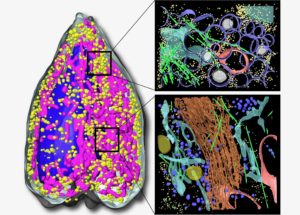
Soft X-ray tomography provides a map of organelles within an intact cell. (Credit: Katya Kadyshevskaya/USC)
The planet is comprised of continents and islands, each with unique cultures and resources. One area may be well known for growing food, another for manufacturing building materials, and yet despite their differences and distance from one another, the regions are linked by global processes. Living cells are built on a similar concept. For example, one part of the cell produces fuel that powers life, and another part makes the simple building blocks that are then assembled into complex structures inside the cell. To fully understand cells, we need to characterize the structures that make them up, and to identify their contents.
Thanks to advanced imaging technologies, scientists have examined many different components of cells, and some current approaches can even map the structure of these molecules down to each atom. However, getting a glimpse of how all these parts move, change, and interact within a dynamic, living cell has always been a grander challenge.
A team based at Berkeley Lab’s Advanced Light Source is making waves with its new approach for whole-cell visualization, using the world’s first soft X-ray tomography (SXT) microscope built for biological and biomedical research. In its latest study, published in Science Advances, the team used its platform to reveal never-before-seen details about insulin secretion in pancreatic cells taken from rats. This work was done in collaboration with a consortium of researchers dedicated to whole-cell modeling, called the Pancreatic β-Cell Consortium.
“Our data shows that SXT is a powerful tool to quantify subcellular rearrangements in response to drugs,” said author Carolyn Larabell, Director of the National Center for X-ray Tomography (NCXT) and a Berkeley Lab faculty scientist in the Molecular Biophysics and Integrated Bioimaging Division. “This is an important first step for bridging the longstanding gap between structural biology and physiology.”
Larabell and the other authors note that SXT is uniquely suited to image whole cells without alterations from stains or added tagging molecules – as is the case for fluorescence imaging – and without chemically fixing and sectioning them, which is necessary for traditional electron microscopy. Also, SXT has a much faster and easier cell preparation process.

The image on the left shows a 3D volumetric view of a pancreatic beta cell obtained using soft x-ray tomography, with the distribution of insulin granules (yellow), mitochondria (pink) and the nucleus (blue) highlighted. The boxed regions point to structural details of these regions obtained using cryo-electron tomography, as part of another study. (Credit: Valentina Loconte/UCSF and NCXT; and Kate White/USC)
Free from the traditional technical and temporal constraints, the team could visualize isolated insulin-secreting cells (called beta cells) before, during, and after stimulation from exposure to differing levels of glucose and an insulin-boosting drug. In rats and other mammals, beta cells respond to rising blood glucose levels by releasing insulin. This hormone regulates glucose metabolism throughout the body.
“We found that stimulating beta cells induced rapid changes in the numbers and molecular densities of insulin vesicles – the membrane ‘envelopes’ that the insulin is stored in after production,” said Larabell. “This was surprising at first, because we expected that we should see fewer vesicles during secretion when they are emptied outside the cell. But what we observe is a rapid maturation of existing immature vesicles.”
The Advanced Light Source is a Department of Energy Office of Science user facility. NCXT is funded by the National Institutes of Health and the DOE Office of Science.
# # #
Founded in 1931 on the belief that the biggest scientific challenges are best addressed by teams, Lawrence Berkeley National Laboratory and its scientists have been recognized with 14 Nobel Prizes. Today, Berkeley Lab researchers develop sustainable energy and environmental solutions, create useful new materials, advance the frontiers of computing, and probe the mysteries of life, matter, and the universe. Scientists from around the world rely on the Lab’s facilities for their own discovery science. Berkeley Lab is a multiprogram national laboratory, managed by the University of California for the U.S. Department of Energy’s Office of Science.
DOE’s Office of Science is the single largest supporter of basic research in the physical sciences in the United States, and is working to address some of the most pressing challenges of our time. For more information, please visit energy.gov/science.